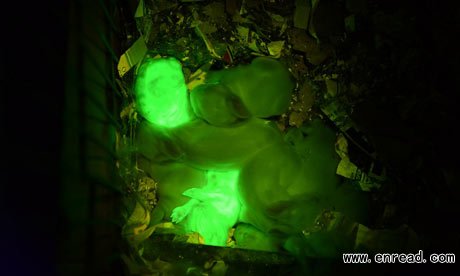| ||||||||||||||||||||||||||||||||||||||||||||||||||||||||||||||||||||||||||||||||||||||||
|
As part of an effort to improve treatments for life-threatening illnesses, a team of scientists have created rabbits that glow in the dark.
伊斯坦布尔和夏威夷大学的研究人员培育出能在黑暗中发光的兔子。
 DNA1 into the mother rabbit\s embryos2 and reinserting these into the mother's womb." style="cursor:pointer" onclick="window.open('/upimg/allimg/130819/1_130819080024_1.jpg')" /> DNA1 into the mother rabbit\s embryos2 and reinserting these into the mother's womb." style="cursor:pointer" onclick="window.open('/upimg/allimg/130819/1_130819080024_1.jpg')" />The glowing effect was created by injecting jellyfish DNA into the mother rabbit\s embryos and reinserting these into the mother's womb. Their efforts produced two rabbits out of a litter of eight that went from being a normal, fluffy3(蓬松的) white to glowing green in the dark. The rabbits were born at the University of Istanbul as part of a collaboration4 between scientists from universities in Turkey and Hawaii.
The rabbits glow to show that a genetic5 manipulation technique can work efficiently6, though the specific color is more cosmetic7 than scientific. "The green is not important at all – it's just a marker to show the experiment can be done successfully," said University of Hawaii associate professor Stefan Moisyadi.
To produce the glowing effect, researchers injected jellyfish DNA into a mother rabbit's embryos. Those altered embryos were then inserted back into the mother. Similar experiments have resulted in glowing cockroaches8 and cats.
Eventually, the researchers hope the technique can lead to new ways to produce medicines, Moisyadi said.
"The final goal is to develop animals that act as barrier reactives to produce beneficial molecules9 in their milk that can be cheaply extracted, especially in countries that can not afford big pharma plants that make drugs, that usually cost $1bn to build, and be able to produce their own protein-based medication in animals," Moisyadi said.
The rabbits are expected to have the same life span as their non-glowing counterparts, but Moisyadi said he understands people can object to this kind of experimentation10 involving live animals.
"To the people against, I say: think about, what are the benefits and what are the injuries?" Moisyadi said. "And if the benefits outweigh11 the injuries, let's go with the benefits."
Moisyadi, a native of Turkey who is now with the University of Hawaii, started developing the project in 2006, and researchers are now waiting to see if pregnant sheep produce similar results.
点击  收听单词发音 收听单词发音
|
||||||||||||||||||||||||||||||||||||||||||||||||||||||||||||||||||||||||||||||||||||||||
上一篇:荷兰教授用干细胞制造牛肉 下一篇:美国小姐妹制作出可运转的火星探测器模型 |
||||||||||||||||||||||||||||||||||||||||||||||||||||||||||||||||||||||||||||||||||||||||
- 发表评论
-
- 最新评论 进入详细评论页>>



